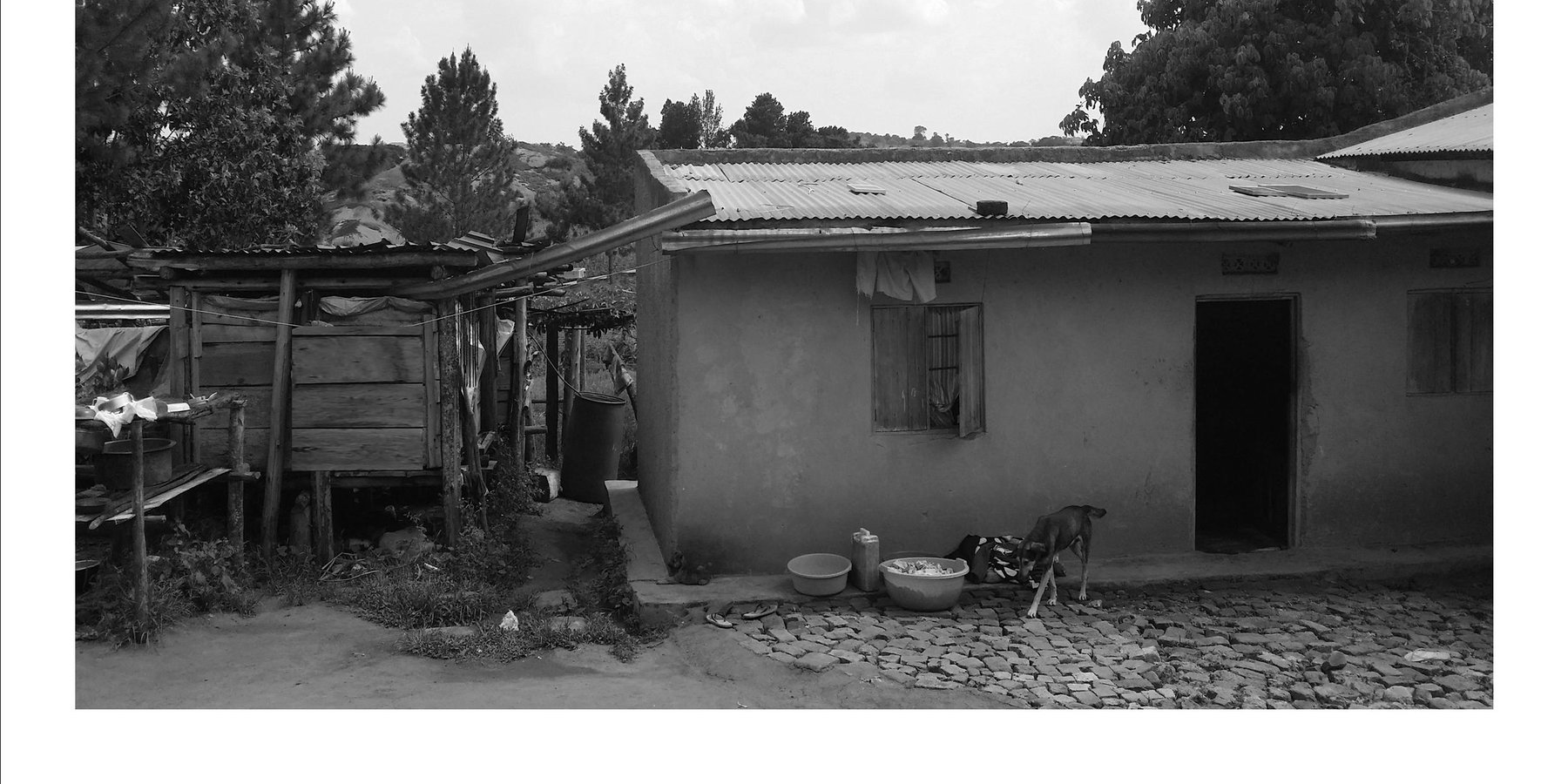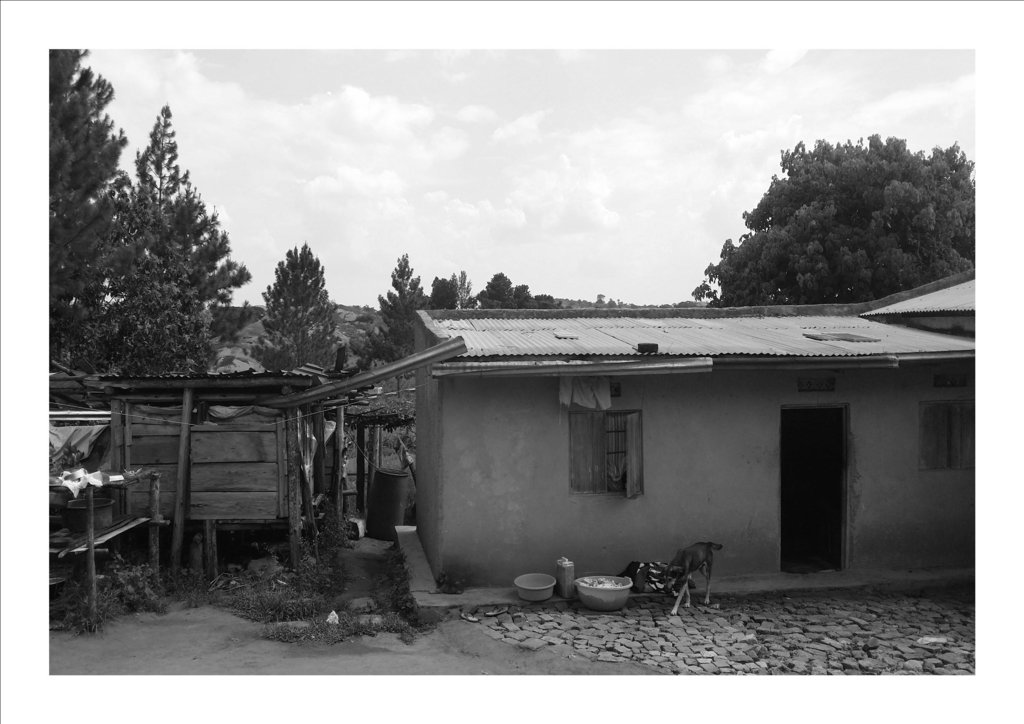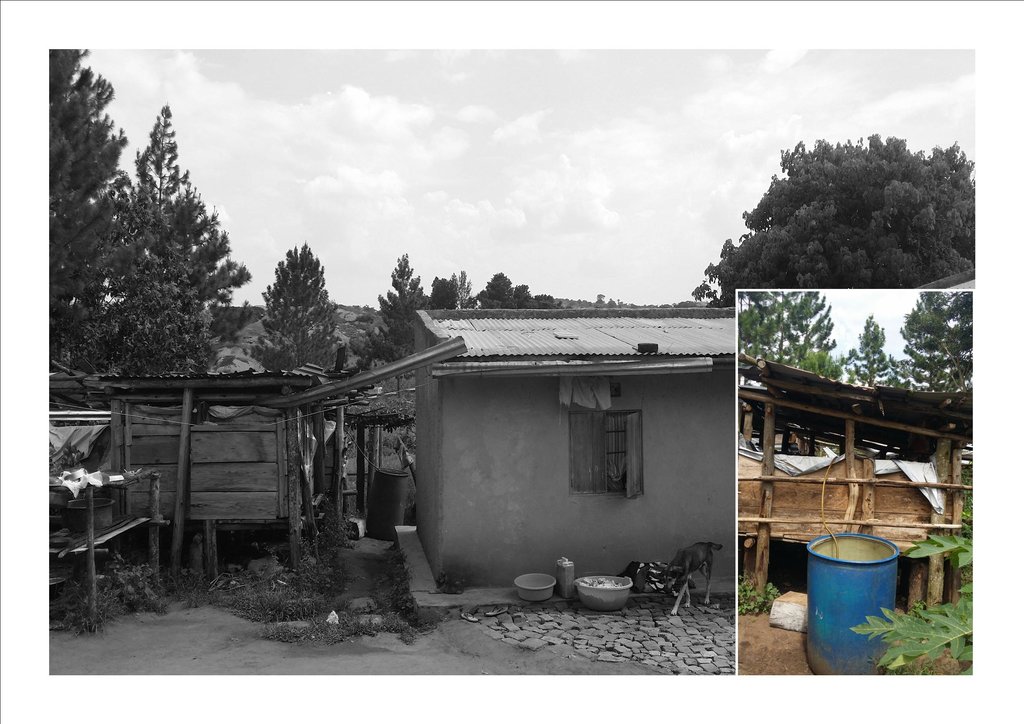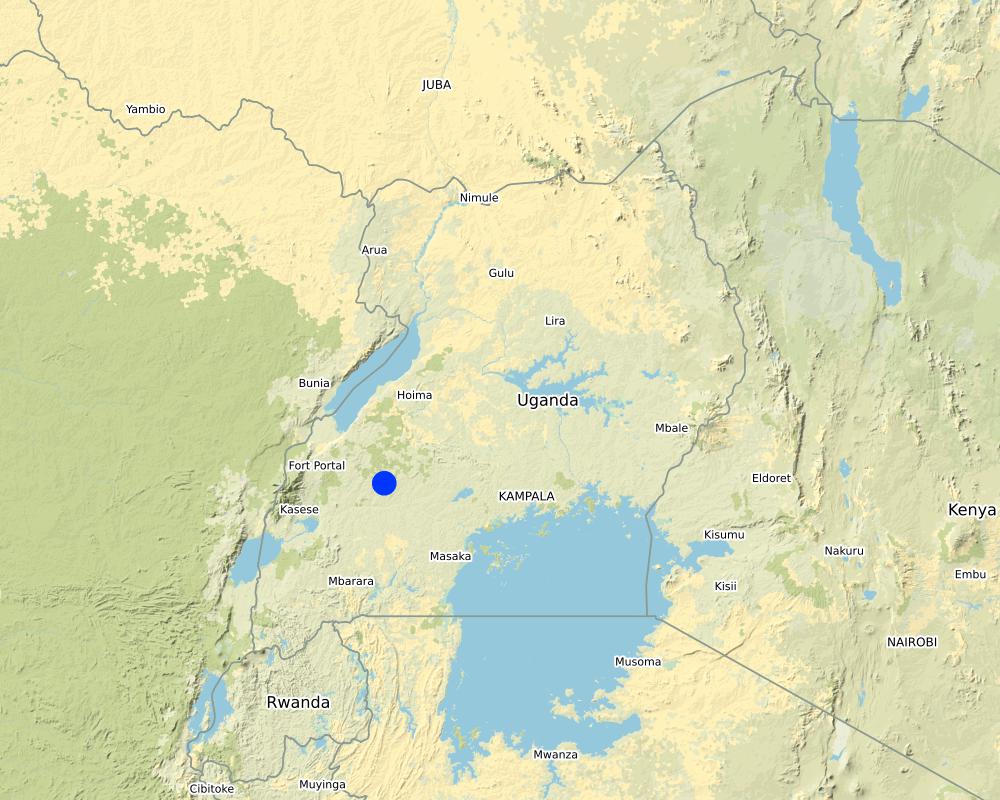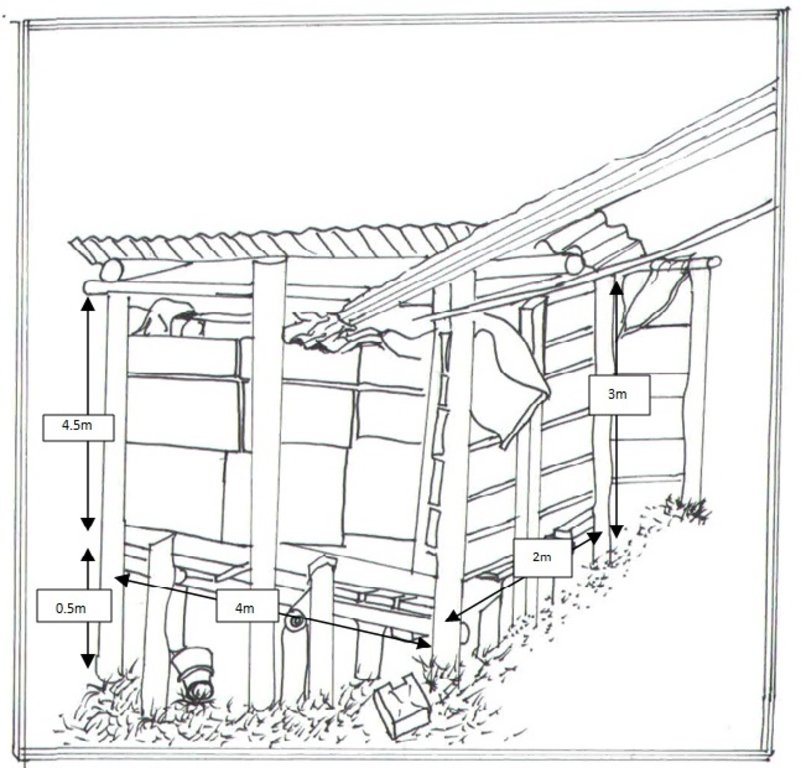Wooden water reservoir for rain water harvesting. [អ៊ូហ្គង់ដា]
- ការបង្កើត៖
- បច្ចុប្បន្នភាព
- អ្នកចងក្រង៖ Aine Amon
- អ្នកកែសម្រួល៖ Kamugisha Rick Nelson
- អ្នកត្រួតពិនិត្យច្រើនទៀត៖ Nicole Harari, Udo Höggel
Okutagila amizi aha ibati
technologies_3301 - អ៊ូហ្គង់ដា
ពិនិត្យមើលគ្រប់ផ្នែក
ពង្រីកមើលទាំងអស់ បង្រួមទាំងអស់1. ព័ត៌មានទូទៅ
1.2 ព័ត៌មានលម្អិតពីបុគ្គលសំខាន់ៗ និងស្ថាប័នដែលចូលរួមក្នុងការវាយតម្លៃ និងចងក្រងឯកសារនៃបច្ចេកទេស
បុគ្គលសំខាន់ម្នាក់ (ច្រើននាក់)
អ្នកប្រើប្រាស់ដី:
Kabanda Deo
Mubende, Mubende Municipality
អ៊ូហ្គង់ដា
ឈ្មោះគម្រោងដែលបានចងក្រងឯកសារ/ វាយតម្លៃលើបច្ចេកទេស (បើទាក់ទង)
Scaling-up SLM practices by smallholder farmers (IFAD)ឈ្មោះអង្គភាពមួយ (ច្រើន) ដែលបានចងក្រងឯកសារ/ វាយតម្លៃបច្ចេកទេស (បើទាក់ទង)
National Agricultural Research Organisation (NARO) - អ៊ូហ្គង់ដា1.3 លក្ខខណ្ឌទាក់ទងទៅនឹងការប្រើប្រាស់ទិន្នន័យដែលបានចងក្រងតាមរយៈ វ៉ូខេត
តើពេលណាដែលទិន្នន័យបានចងក្រង (នៅទីវាល)?
13/11/2017
អ្នកចងក្រង និង(បុគ្គលសំខាន់ៗ)យល់ព្រមទទួលយកនូវលក្ខខណ្ឌនានាទាក់ទងទៅនឹងការប្រើប្រាស់ទិន្នន័យដែលបានចងក្រងតាមរយៈវ៉ូខេត:
បាទ/ចា៎
1.4 សេចក្តីប្រកាសស្តីពីចីរភាពនៃការពណ៌នាពីបច្ចេកទេស
តើបច្ចេកទេសដែលបានពណ៌នានេះមានបញ្ហាដែលផ្តោតលើការធ្លាក់ចុះគុណភាពដី, បើដូច្នេះវាមិនអាចត្រូវបានប្រកាសថាជាបច្ចេកទេសនៃការគ្រប់គ្រងប្រកបដោយចីរភាពទេ?
ទេ
មតិយោបល់:
The reservoir is established out of natural and local materials available to community members and stores relatively clean/safe water for future use.
1.5 ការយោងទៅលើកម្រងបញ្ជីសំណួរនៃវិធីសាស្ត្រផ្សព្វផ្សាយ SLM

water harvesting [ប្រទេសកេនយ៉ា]
Water harvesting for agricultural production in ASALS.
- អ្នកចងក្រង៖ Philippe Zahner
2. ការពណ៌នាពីបច្ចេកទេស SLM
2.1 ការពណ៌នាដោយសង្ខេបពីបច្ចេកទេស
និយមន័យបច្ចេកទេស:
A gutter system constructed on the farmer’s house-roof collects rainwater and directs it into a constructed reservoir raised off the ground with interior walls lined with water-proof tarpaulin. The reservoir has a maximum capacity of 8,000 liters of water; clean enough for irrigation, livestock and domestic use during seasons of scarcity. The reservoir is raised off of ground to minimize contamination and any possible accidents.
2.2 ការពណ៌នាលម្អិតពីបច្ចេកទេស
ការពណ៌នា:
The wooden water reservoir system was introduced to the farmer by staff of the area's local government as a demonstration site to educate others on how to cheaply harvest and store rainwater in a relatively clean form for domestic, livestock and irrigation use. The farmer’s house was fitted with gutters to tap rainwater and direct it into the water reservoir. The water collected is used to buffer the water scarcity during the dry season, which normally stresses livestock and crops in the area. The water can be stored for as long as three months, depending on the size of the water reservoir and the use of the water.
The establishment of the technology requires a clean roof for collecting rainwater, gutters, poles, iron sheets, tarpaulin, hose pipe, jerry can and nails. Further equipment required include; a hammer, hoe and panga (large knife for weeding and forest works). At the farm in Kyegegwa, the reservoir is constructed 3 meters away from the farmer’s main house located at the top of a gently sloping hill. The establishment process involves: leveling of the site on which the technology is planned and constructing a water reservoir supported by a wooden structure. The support structure is constructed using four poles made in such a way that the two front poles are taller (5m) while the two poles behind are shorter (3m). This will give the roof a slight slope to prevent rainwater from stagnating on the roof. A raised rectangular floor supported by the poles is then established at a height of 0.5m above ground. The rectangular reservoir base dimensions are 1m×4m×2m (h×l×w) and is divided into 4 compartment. Each of these, lined with water-tight tarpaulin, can hold 2000 litres of water. The water so collected in the reservoir can be extracted under gravity through a 1.5cm diameter hose pipe into a jerry can placed below the reservoir.
The cost of establishment and durability of this rainwater harvesting system is mainly dependent on the type of materials and gutters used. In Kyegegwa District, wood for construction of the system is locally available valued at US$ 67.99 for the construction of the reservoir system. The iron sheets, gutters and nails are acquired from Kyegegwa Town where they are valued at US$ 127.28. The labor required is also locally available where it takes four men to establish the structure at a total cost of US$ 17.95 in three days.
The water reservoir is semi-permanent and can last for about 1.5 years depending on the quality of materials used. The maintenance activities include cleaning of the reservoir every month and repairing of the worn out parts at the end of the wet season. The farmer strongly recommends the technology since most of the materials and labour used are relatively cheap and locally available. The reservoir is raised off the ground to reduce contamination and minimize possible accidents with children and livestock. Despite the open space above the water level and the roof, the farmer has observed that the reservoir does not breed obnoxious vectors like mosquitoes. The water collected is relatively clean and the farmer uses it for irrigation of home gardens and for watering of livestock. When properly filtered it is as well used for domestic purposes. The technology can be improved by using treated poles, stronger wood material and tarpaulin of improved quality.
2.3 រូបភាពនៃបច្ចេកទេស
កំណត់សម្គាល់ទូទៅនៃរូបថត/រូភាព:
The black and white view shows the water system including the house roof, improvised iron sheet gutters and water reservoir structure. The colored picture shows a hose pipe connected into the reservoir to deliver water into the plastic tank by forces of gravity
2.4 វីដេអូនៃបច្ចេកទេស
កាលបរិច្ឆេទ:
13/11/2017
ទីតាំង:
Kyeggegwa Town Council
ឈ្មោះអ្នកថតវីឌីអូ:
Amon Aine
2.5 ប្រទេស/តំបន់/ទីតាំងកន្លែង ដែលបច្ចេកទេសត្រូវបានអនុវត្ត និងបានគ្រប់ដណ្តប់ដោយការវាយតម្លៃនេះ
ប្រទេស:
អ៊ូហ្គង់ដា
តំបន់/រដ្ឋ/ខេត្ត:
Western
បញ្ជាក់បន្ថែមពីលក្ខណៈនៃទីតាំង:
Kyeggegwa
មតិយោបល់:
The project is located at the top of a gently sloping hill
Map
×2.6 កាលបរិច្ឆេទនៃការអនុវត្ត
បង្ហាញឆ្នាំនៃការចុះអនុវត្ត:
2015
2.7 ការណែនាំពីបច្ចេកទេស
សូមបញ្ជាក់តើបច្ចេកទេសត្រូវបានណែនាំឱ្យអនុវត្តដោយរបៀបណា:
- តាមរយៈគម្រោង / អន្តរាគមន៍ពីខាងក្រៅ
មតិយោបល់ (ប្រភេទនៃគម្រោង ។ល។):
Local Government project to help local farmers adopting water storage systems for use during drought.
3. ចំណាត់ថ្នាក់នៃបច្ចេកទេស SLM
3.1 គោលបំណងចម្បង (១ ឬច្រើន) នៃបច្ចេកទេសនេះ
- ធ្វើឱ្យប្រសើរឡើងនូវផលិតកម្ម
- កាត់បន្ថយហានិភ័យនៃគ្រោះមហន្តរាយ
- បន្ស៊ាំទៅនឹងការប្រែប្រួលអាកាសធាតុ/គ្រោះមហន្តរាយ និងផលប៉ះពាល់របស់វា
- បង្កើតផលប្រយោជន៍សេដ្ឋកិច្ច
3.2 ប្រភេទដីប្រើប្រាស់មួយប្រភេទ (ច្រើនប្រភេទ) ដែលបានអនុវត្តបច្ចេកទេស

លំនៅដ្ឋាន ហេដ្ឋារចនាសម្ព័ន្ធ
- ដីលំនៅស្ថាន អគារ
កំណត់សម្គាល់:
The farmer's house roof top is used as the rain water catchment area.
3.3 ព័ត៌មានបន្ថែមអំពីអ្នកប្រើប្រាស់ដី
ការផ្គត់ផ្គង់ទឹកនៅកន្លែងអនុវត្តបច្ចេកទេស:
- ទឹកភ្លៀង និងប្រព័ន្ធស្រោចស្រព
ចំនួនសារដែលដាំដំណាំក្នុងមួយឆ្នាំ:
- 2
សូមបញ្ជាក់:
March-May and Sept-Nov. However, due to climate change, the seasons vary significantly in length and amount of rain recieved.
3.4 ក្រុម SLM ដែលបច្ចេកទេសស្ថិតនៅក្នុង
- ការស្តុកទុកទឹក
3.5 ការសាយភាយនៃបច្ចេកទេស
បញ្ជាក់ពីការសាយភាយនៃបច្ចេកទេស:
- អនុវត្តនៅកន្លែងជាក់លាក់មួយ/ ប្រមូលផ្តុំនៅតំបន់តូចៗ
3.6 វិធានការ SLM ដែលបញ្ចូលនូវបច្ចេកទេស

វិធានការរចនាស័ម្ពន្ធ
- S6: ជញ្ជាំង, របាំង, របងឈើខ្ពស់ៗ
- S7: ការប្រមូលទឹកស្តុកទុក/ផ្គត់ផ្គង់ទឹក/ សម្ភារៈស្រោចស្រព
3.7 កំណត់ប្រភេទនៃការធ្លាក់ចុះគុណភាពដីសំខាន់ៗដែលបច្ចេកទេសនេះបានដោះស្រាយ

ការបាត់បង់ទឹក
- Ha: ការថយចុះសំណើមដី
មតិយោបល់:
To provide safe water for domestic, livestock and irrigation use especially during the drought period.
3.8 ការពារ កាត់បន្ថយ ឬស្តារឡើងវិញនៃការធ្លាក់ចុះគុណភាពដី
បញ្ជាក់ពីគោលដៅរបស់បច្ចេកទេស ដែលផ្តោតទៅការធ្លាក់ចុះគុណភាពដី:
- ការការពារការធ្លាក់ចុះគុណភាពដី
- ការបន្ស៊ាំទៅនឹងការធ្លាក់ចុះគុណភាពដី
មតិយោបល់:
Harvesting rain water reduces the need for constructing dams.
4. បច្ចេកទេសជាក់លាក់ សកម្មភាពអនុវត្ត ធាតុចូល និងថ្លៃដើម
4.1 គំនូសបច្ចេកទេសនៃបច្ចេកទេសនេះ
4.2 លក្ខណៈពិសេសនៃបច្ចេកទេស/ ពណ៌នាពីគំនូរបច្ចេកទេស
The support structure is constructed using four poles made in such a way that the two front poles are taller (5 m) while the two poles behind are shorter (3 m), giving the roof a slight slope to prevent rainwater from stagnating on the roof. A raised rectangular floor supported by the poles is then established at a height of 0.5 m above ground. A cuboid reservoir of dimensions 1 m×4 m×2 m (h×l×w) is constructed with wooden panels; divided into four compartments and placed on the rectangular floor. Each compartment, to hold 2,000 liter of water, is lined with water-tight tarpaulin. Water from the reservoir can be extracted under gravity through a 1.5 cm diameter hose pipe into a jerry can placed below the reservoir.
4.3 ព័ត៌មានទូទៅដែលពាក់ព័ន្ធនឹងការគណនាធាតុចូល និងថ្លៃដើម
កំណត់របៀបនៃការគណនាថ្លៃដើម និងធាតុចូល:
- ក្នុងឯកតាបច្ចេកទេស
បញ្ជាក់ឯកតា:
Water Reservior
បញ្ជាក់ទំហំ ប្រវែង ។ល។ (បើពាក់ព័ន្ធ):
Capacity 8000 liters, segregated into 4 compartments
ផ្សេងៗ/ រូបិយប័ណ្ណជាតិ (បញ្ជាក់):
Uganda shillings
កំណត់អត្រាប្តូរប្រាក់ពីដុល្លាទៅរូបិយប័ណ្ណតំបន់ (បើទាក់ទង)៖ 1 ដុល្លារ =:
3638,35
កំណត់ថ្លៃឈ្នួលជាមធ្យមនៃការជួលកម្លាំងពលកម្មក្នុងមួយថ្ងៃ:
20000
4.4 សកម្មភាពបង្កើត
| សកម្មភាព | ប្រភេទវិធានការ | ពេលវេលា | |
|---|---|---|---|
| 1. | Site selection | រចនាសម្ព័ន្ធ | Before onset of rain |
| 2. | Clearing and leveling | រចនាសម្ព័ន្ធ | Before onset of rain |
| 3. | Erection of poles | រចនាសម្ព័ន្ធ | Before onset of rain |
| 4. | Establishment of floor, walls and roofing | រចនាសម្ព័ន្ធ | Before onset of rain |
| 5. | Establishment of taupline and gutters | រចនាសម្ព័ន្ធ | Before onset of rain |
4.5 ថ្លៃដើម និងធាតុចូលដែលត្រូវការសម្រាប់ការបង្កើតបច្ចេកទេស
| បញ្ជាក់ពីធាតុចូល | ឯកតា | បរិមាណ | ថ្លៃដើមក្នុងមួយឯកតា | ថ្លៃធាតុចូលសរុប | % នៃថ្លៃដើមដែលចំណាយដោយអ្នកប្រើប្រាស់ដី | |
|---|---|---|---|---|---|---|
| កម្លាំងពលកម្ម | Builders | Man day | 8,0 | 22500,0 | 180000,0 | 100,0 |
| សម្ភារៈ | Hammer | pieces | 30000,0 | 1,0 | 30000,0 | 100,0 |
| សម្ភារៈ | Panga | pieces | 9000,0 | 1,0 | 9000,0 | 100,0 |
| សម្ភារៈ | Dibber | pieces | 15000,0 | 1,0 | 15000,0 | 100,0 |
| សម្ភារៈ | Hoe | pieces | 10000,0 | 1,0 | 10000,0 | 100,0 |
| សម្ភារៈដាំដុះ | Spade | pieces | 15000,0 | |||
| សម្ភារៈដាំដុះ | Poles | pieces | 12,0 | 3000,0 | 36000,0 | 100,0 |
| សម្ភារៈដាំដុះ | Timber | pieces | 12,0 | 10000,0 | 120000,0 | 100,0 |
| សម្ភារៈដាំដុះ | Wood | pieces | 8,0 | 1500,0 | 12000,0 | 100,0 |
| សម្ភារៈសាងសង់ | Tarpaulin | peices | 1,0 | 45000,0 | 45000,0 | |
| សម្ភារៈសាងសង់ | Iron sheet | peices | 6,0 | 25000,0 | 150000,0 | |
| សម្ភារៈសាងសង់ | Nails | Kg | 4,0 | 6000,0 | 24000,0 | |
| សម្ភារៈសាងសង់ | Hose pipe | Meters | 3,0 | 3000,0 | 9000,0 | |
| សម្ភារៈសាងសង់ | Wood and poles | Pieces | 50,0 | 4900,0 | 245000,0 | |
| ថ្លៃដើមសរុបក្នុងការបង្កើតបច្ចេកទេស | 885000,0 | |||||
ប្រសិនបើអ្នកប្រើប្រាស់ដីមិនមានថ្លៃដើម 100% សូមបញ្ជាក់ថានរណាដែលចំណាយថ្លៃដើមដែលនៅសល់:
Kyegegwa District Local Government Community Development Fund.
មតិយោបល់:
The poles and wood are from the farmer's forest. The labor used was also family labor.
4.6 សកម្មភាពថែទាំ
| សកម្មភាព | ប្រភេទវិធានការ | ពេលវេលា/ ភាពញឹកញាប់ | |
|---|---|---|---|
| 1. | Cleaning the reservoir/ tarpaulin and unblocking gutters | ការគ្រប់គ្រង | Twice in the wet season |
| 2. | Renovation of the structure | រចនាសម្ព័ន្ធ | Once a year |
| 3. | Replacement of the taupline | រចនាសម្ព័ន្ធ | Once a year |
4.7 កំណត់ថ្លៃដើមសម្រាប់ការថែទាំ/ សកម្មភាពរបស់បច្ចេកទេស (ក្នុងរយៈពេលមួយឆ្នាំ)
| បញ្ជាក់ពីធាតុចូល | ឯកតា | បរិមាណ | ថ្លៃដើមក្នុងមួយឯកតា | ថ្លៃធាតុចូលសរុប | % នៃថ្លៃដើមដែលចំណាយដោយអ្នកប្រើប្រាស់ដី | |
|---|---|---|---|---|---|---|
| កម្លាំងពលកម្ម | Men | 2,0 | 20000,0 | 40000,0 | 100,0 | |
| សម្ភារៈ | Hose pipe | meters | 3,0 | 2000,0 | 6000,0 | 100,0 |
| សម្ភារៈ | Jerrycans | 20litres | 2,0 | 9000,0 | 18000,0 | 100,0 |
| សម្ភារៈសាងសង់ | Poles | pieces | 6,0 | 3000,0 | 18000,0 | 100,0 |
| សម្ភារៈសាងសង់ | Timber | pieces | 6,0 | 10000,0 | 60000,0 | 100,0 |
| សម្ភារៈសាងសង់ | Wood | pieces | 5,0 | 1500,0 | 7500,0 | 100,0 |
| ថ្លៃដើមសរុបសម្រាប់ការថែទាំដំណាំតាមបច្ចេកទេស | 149500,0 | |||||
ប្រសិនបើអ្នកប្រើប្រាស់ដីមិនមានថ្លៃដើម 100% សូមបញ្ជាក់ថានរណាដែលចំណាយថ្លៃដើមដែលនៅសល់:
Kyegegwa District Local Government
4.8 កត្តាសំខាន់បំផុតដែលមានឥទ្ធិពលដល់ការចំណាយ
ពណ៌នាពីកត្តាប៉ះពាល់ចម្បងៗទៅលើថ្លៃដើម:
The nature of material used for example wood or metal and the labor hired to construct the system.
5. លក្ខណៈបរិស្ថានធម្មជាតិ និងមនុស្ស
5.1 អាកាសធាតុ
បរិមាណទឹកភ្លៀងប្រចាំឆ្នាំ
- < 250 មម
- 251-500 មម
- 501-750 មម
- 751-1,000 មម
- 1,001-1,500 មម
- 1,501-2,000 មម
- 2,001-3,000 មម
- 3,001-4,000 មម
- > 4,000 មម
លក្ខណៈពិសេស/ មតិយោបល់លើរដូវភ្លៀង:
The rain seasons run from March-May and Sept-Nov.
តំបន់កសិអាកាសធាតុ
- សើម
5.2 សណ្ឋានដី
ជម្រាលជាមធ្យម:
- រាបស្មើ (0-2%)
- ជម្រាលតិចតួច (3-5%)
- មធ្យម (6-10%)
- ជម្រាលខ្ពស់បន្តិច (11-15%)
- ទីទួល (16-30%)
- ទីទួលចោត (31-60%)
- ទីទួលចោតខ្លាំង (>60%)
ទម្រង់ដី:
- ខ្ពង់រាប
- កំពូលភ្នំ
- ជម្រាលភ្នំ
- ជម្រាលទួល
- ជម្រាលជើងភ្នំ
- បាតជ្រលងភ្នំ
តំបន់តាមរយៈកម្ពស់ :
- 0-100 ម
- 101-500 ម
- 501-1,000 ម
- 1,001-1,500 ម
- 1,501-2,000 ម
- 2,001-2,500 ម
- 2,501-3,000 ម
- 3,001-4,000 ម
- > 4,000 ម
បញ្ជាក់ថាតើបច្ចេកទេសនេះត្រូវបានអនុវត្តន៍នៅក្នុង:
- មិនពាក់ព័ន្ធទាំងអស់
5.3 ដី
ជម្រៅដីជាមធ្យម:
- រាក់ខ្លាំង (0-20 សម)
- រាក់ (21-50 សម)
- មធ្យម (51-80 សម)
- ជ្រៅ (81-120 សម)
- ជ្រៅខ្លាំង (> 120 សម)
វាយនភាពដី (ស្រទាប់លើ):
- មធ្យម (ល្បាយ, ល្បាប់)
វាយនភាពដី (> 20 សម ស្រទាប់ក្នុង):
- មធ្យម (ល្បាយ, ល្បាប់)
សារធាតុសរីរាង្គនៅស្រទាប់ដីខាងលើ:
- មធ្យម (1-3%)
5.4 ទឹកដែលអាចទាញមកប្រើប្រាស់បាន និងគុណភាពទឹក
នីវ៉ូទឹកក្រោមដី:
> 50 ម
ទឹកលើដីដែលអាចទាញយកប្រើប្រាស់បាន:
កម្រិតមធ្យម
គុណភាពទឹក (មិនបានធ្វើប្រត្តិកម្ម):
ទឹកពិសារដែលគ្មានគុណភាព (តម្រូវឱ្យមានការសំអាត)
តើមានបញ្ហាភាពទឹកប្រៃហូរចូលមកដែរឬទេ?
ទេ
តើទឹកជំនន់កំពុងកើតមាននៅតំបន់នេះដែររឺទេ?
ទេ
5.5 ជីវៈចម្រុះ
ភាពសម្បូរបែបនៃប្រភេទ:
- កម្រិតមធ្យម
ភាពសម្បូរបែបនៃទីជម្រក:
- កម្រិតមធ្យម
5.6 លក្ខណៈនៃអ្នកប្រើប្រាស់ដីដែលអនុវត្តបច្ចេកទេស
នៅមួយកន្លែង ឬពនេចរ :
- នៅមួយកន្លែង
ទីផ្សារនៃប្រព័ន្ធផលិតកម្ម:
- សម្រាប់ហូបក្នុងគ្រួសារ (ផ្គត់ផ្គង់ខ្លួនឯង)
ចំណូលក្រៅកសិកម្ម:
- 10-50% នៃចំណូល
កម្រិតជីវភាព:
- មធ្យម
ឯកជន ឬក្រុម:
- ធ្វើខ្លួនឯង/ គ្រួសារ
កម្រិតប្រើប្រាស់គ្រឿងយន្ត:
- ប្រើកម្លាំងពលកម្ម
យេនឌ័រ:
- បុរស
អាយុរបស់អ្នកប្រើប្រាស់ដី:
- មនុស្សចាស់
5.7 ទំហំផ្ទៃដីជាមធ្យមនៃដីផ្ទាល់ខ្លួន ឬជួលគេដែលបានអនុវត្តបច្ចេកទេស
- < 0.5 ហិកតា
- 0.5-1 ហិកតា
- 1-2 ហិកតា
- 2-5 ហិកតា
- 5-15 ហិកតា
- 15-50 ហិកតា
- 50-100 ហិកតា
- 100-500 ហិកតា
- 500-1,000 ហិកតា
- 1,000-10,000 ហិកតា
- > 10,000 ហិកតា
តើផ្ទៃដីនេះចាត់ទុកជាទំហំកម្រិតណាដែរ ខ្នាតតូច មធ្យម ឬខ្នាតធំ (ធៀបនឹងបរិបទតំបន់)?
- ខ្នាតមធ្យម
5.8 ភាពជាម្ចាស់ដី កម្មសិទ្ធប្រើប្រាស់ដី និងកម្មសិទ្ធប្រើប្រាស់ទឹក
ភាពជាម្ចាស់ដី:
- ឯកជន មានកម្មសិទ្ធ
កម្មសិទ្ធិប្រើប្រាស់ដី:
- ឯកជន
កម្មសិទ្ធប្រើប្រាស់ទឹក:
- ជាក្រុម (មានដែនកំណត់)
- ឯកជន
5.9 ការប្រើប្រាស់សេវាកម្ម និងហេដ្ឋារចនាសម្ព័ន្ធ
សុខភាព:
- មិនល្អ
- មធ្យម
- ល្អ
ការអប់រំ:
- មិនល្អ
- មធ្យម
- ល្អ
ជំនួយបច្ចេកទេស:
- មិនល្អ
- មធ្យម
- ល្អ
ការងារ (ឧ. ការងារក្រៅកសិដ្ឋាន):
- មិនល្អ
- មធ្យម
- ល្អ
ទីផ្សារ:
- មិនល្អ
- មធ្យម
- ល្អ
ថាមពល:
- មិនល្អ
- មធ្យម
- ល្អ
ផ្លូវ និងការដឹកជញ្ជូន:
- មិនល្អ
- មធ្យម
- ល្អ
ទឹកផឹក និងអនាម័យ:
- មិនល្អ
- មធ្យម
- ល្អ
សេវាកម្មហិរញ្ញវត្ថុ:
- មិនល្អ
- មធ្យម
- ល្អ
6. ផលប៉ះពាល់ និងការសន្និដ្ឋាន
6.1 ផលប៉ះពាល់ក្នុងបរិវេណអនុវត្តបច្ចេកទេសដែលកើតមាន
ផលប៉ះពាល់លើសេដ្ឋកិច្ចសង្គម
ផលិតផល
ផលិតកម្មដំណាំ
គុណភាពដំណាំ
ផលិតកម្មចំណីសត្វ
គុណភាពចំណីសត្វ
ផលិតកម្មសត្វ
ផលិតកម្មឈើ
គុណភាពព្រៃឈើ/ដីព្រៃ
អនុផលព្រៃឈើ
ហានិភ័យនៃភាពបរាជ័យរបស់ផលិតកម្ម
ភាពសម្បូរបែបនៃផលិតផល
ផ្ទៃដីផលិតកម្ម
ការគ្រប់គ្រងដី
ទឹកដែលអាចទាញមកប្រើប្រាស់បាន និងគុណភាពទឹក
ទឹកបរិភោគដែលអាចទាញយកមកប្រើប្រាស់បាន
គុណភាពក្រោយ SLM:
80000 litres in storage by end of the wet season
គុណភាពទឹកបរិភោគ
មតិយោបល់/ ការបញ្ជាក់:
The water stored in the tank is relatively clean compared to that harvested previously using the run off harvest system.
ទឹកដែលអាចប្រើប្រាស់បានសម្រាប់ការចិញ្ចឹមសត្វ
គុណភាពទឹកសម្រាប់ការចិញ្ចឹមសត្វ
ទឹកប្រើប្រាស់សម្រាប់ស្រោចស្រព
គុណភាពទឹកស្រោចស្រព
ចំណូល និងថ្លៃដើម
ការចំណាយលើធាតុចូលកសិកម្ម
មតិយោបល់/ ការបញ្ជាក់:
Costs on irrigation and income from extended growing seasons
ចំណូលក្នុងកសិដ្ឋាន
ភាពសម្បូរបែបប្រភពប្រាក់ចំណូល
ភាពខុសគ្នាផ្នែកសេដ្ឋកិច្ច
បន្ទុកការងារ
ផលប៉ះពាល់ទៅលើវប្បធម៌សង្គម
សន្តិសុខស្បៀង/ ភាពគ្រប់គ្រាន់ខ្លួនឯង
ស្ថានភាពសុខភាព
មតិយោបល់/ ការបញ្ជាក់:
Improved nutrition since the irrigation water supports growth of vegetables
ឱកាសវប្បធម៍
ឱកាសនៃការបង្កើតថ្មី
ស្ថាប័នសហគមន៍
ផលប៉ះពាល់ទៅលើអេកូឡូស៊ី
វដ្តទឹក/លំហូរ
ការប្រមូលស្តុកទុកទឹក
លំហូរទឹកលើផ្ទៃដី
ប្រព័ន្ធបង្ហូរទឹក
ដី
សំណើមដី
មតិយោបល់/ ការបញ្ជាក់:
Through irrigation in the dry season
វដ្តនៃសារធាតុចិញ្ចឹម/ការទទួលបាន
មតិយោបល់/ ការបញ្ជាក់:
The water facilitates dissolution of nutrients
សារធាតុសរីរាង្គដី/ការបូនក្រោមដី
ជាតិអាស៊ីត
ជីវចម្រុះ៖ ដំណាំ, សត្វ
ដំណាំគម្រប
ជីវម៉ាស/ កាបូនលើដី
ភាពសម្បូរបែបនៃរុក្ខជាតិ
ប្រភេទរាតត្បាត
ភាពសម្បូរបែបនៃសត្វ
ការកាត់បន្ថយហានិភ័យនៃគ្រោះមហន្តរាយ និងគ្រោះអាកាសធាតុ
ផលប៉ះពាល់នៃគ្រោះរាំងស្ងួត
6.2 ផលប៉ះពាល់ក្រៅបរិវេណអនុវត្តបច្ចេកទេសដែលកើតមាន
ទឹកដែលអាចទាញមកប្រើប្រាស់បាន
Buffering/សមត្ថភាពចម្រោះ
6.3 ភាពប្រឈម និងភាពរួសនៃបច្ចេកទេសទៅនឹងការប្រែប្រួលអាកាសធាតុ និងគ្រោះអាកាសធាតុ/ គ្រោះមហន្តរាយ (ដែលដឹងដោយអ្នកប្រើប្រាស់ដី)
គ្រោះអាកាសធាតុ (មហន្តរាយ)
គ្រោះមហន្តរាយអាកាសធាតុ
| លក្ខណៈឆ្លើយតបនៃបច្ចេកទេសទៅនឹងការប្រែប្រួលអាកាសធាតុ | |
|---|---|
| រាំងស្ងួត | ល្អ |
ផលវិបាកដែលទាក់ទងនឹងបរិយាកាសផ្សេងៗទៀត
ផលវិបាកដែលទាក់ទងនឹងបរិយាកាសផ្សេងៗទៀត
| លក្ខណៈឆ្លើយតបនៃបច្ចេកទេសទៅនឹងការប្រែប្រួលអាកាសធាតុ | |
|---|---|
| អូសបន្លាយពេលដាំដុះ | ល្អ |
| Livestock and domestic water | ល្អ |
6.4 ការវិភាគថ្លៃដើម និងអត្ថប្រយោជន៍
តើផលចំណេញ និងថ្លៃដើមត្រូវបានប្រៀបធៀបគ្នាយ៉ាងដូចម្តេច (ទស្សនៈរបស់អ្នកប្រើប្រាស់ដី)?
រយៈពេលខ្លី:
វិជ្ជមាន
រយៈពេលវែង:
វិជ្ជមាន
តើផលចំណេញ និងការថែទាំ/ ជួសជុលត្រូវបានប្រៀបធៀបគ្នាយ៉ាងដូចម្តេច (ទស្សនៈរបស់អ្នកប្រើប្រាស់ដី)?
រយៈពេលខ្លី:
វិជ្ជមានខ្លាំង
រយៈពេលវែង:
វិជ្ជមានខ្លាំង
6.5 ការទទួលយកបច្ចេកទេស
- 1-10%
ក្នុងចំណោមគ្រួសារទាំងអស់ដែលអនុវត្តបច្ចេកទេស តើមានប៉ុន្មានគ្រួសារដែលចង់ធ្វើដោយខ្លួនឯង ដោយមិនទទួលបានសម្ភារៈលើកទឹកចិត្ត/ប្រាក់ឧបត្ថម្ភ?:
- 50-90%
6.6 ការបន្សុំា
តើថ្មីៗនេះ បច្ចេកទេសនេះត្រូវបានកែតម្រូវដើម្បីបន្ស៊ាំទៅនឹងស្ថានភាពប្រែប្រួលដែរឬទេ?
បាទ/ចា៎
ផ្សេងៗ (សូមបញ្ជាក់):
Limited finances
បញ្ជាក់ពីការបន្ស៊ាំនៃបច្ចេកទេស (ការរៀបចំ, ឧបករណ៍/ប្រភេទ ។ល។):
The farmer improvised iron sheets as gutters to collect water from the roof into the reservoir.
6.7 ភាពខ្លាំង/ គុណសម្បត្តិ/ ឱកាសនៃបច្ចេកទេស
| ភាពខ្លាំង/ គុណសម្បត្តិ/ ឱកាសនៅកន្លែងរបស់អ្នកប្រើប្រាស់ដី |
|---|
| Most of the materials are cheap and locally available. |
| The establishment process is not so complex and can easily be learnt by the local workers. |
| The tarpaulin used is relatively cheap and long lasting. |
| ភាពខ្លាំង/ គុណសម្បត្តិ/ ឱកាស ទស្សនៈរបស់បុគ្គលសំខាន់ៗ |
|---|
| The farmer easily benefits from 2 annual rainy seasons. |
| The system is raised off ground which minimizes contamination and accidents. |
| The water is kept in a relatively clean status for livestock, irrigation and domestic use. |
6.8 ភាពខ្សោយ/ គុណវិបត្តិ/ ហានិភ័យនៃបច្ចេកទេស និងវិធីសាស្ត្រដោះស្រាយ
| ភាពខ្សោយ/ គុណវិបត្តិ/ ហានិភ័យ ទស្សនៈរបស់អ្នកប្រើប្រាស់ដី | តើបច្ចេកទេសទាំងនោះបានដោះស្រាយបញ្ហាដូចម្តេច? |
|---|---|
| The water system is open to contamination. | Need to construct a wall net to protect the water from contamination |
| The materials (wood) used are prone to destruction by insects which increases maintenance costs. | Use of metallic or concrete poles |
| ភាពខ្សោយ/ គុណវិបត្តិ/ ហានិភ័យ ទស្សនៈរបស់អ្នកចងក្រងឬបុគ្គលសំខាន់ៗ | តើបច្ចេកទេសទាំងនោះបានដោះស្រាយបញ្ហាដូចម្តេច? |
|---|---|
| The taupline is a temporally reservoir that needs routine replacement. | Use of plastic materials or construction of concrete walls. |
| In case of infestation with insects like termites, the poles will suffer damage. | Use treated wood poles or metal poles. |
7. ឯកសារយោង និងវេបសាយ
7.1 វិធីសាស្ត្រ/ ប្រភពនៃព័ត៌មាន
- តាមការចុះទីវាល ការស្រាវជ្រាវនៅទីវាល
1
- ការសម្ភាសន៍ជាមួយអ្នកប្រើប្រាស់ដី
1
7.2 ឯកសារយោងដែលបានចេញផ្សាយ
ចំណងជើង អ្នកនិពន្ធ ឆ្នាំ ISBN:
Rain Water Harvesting Handbook, Ministry of Water and Environment
មានប្រភពមកពីណា? ថ្លៃដើមប៉ុន្មាន?
https://www.mwe.go.ug/sites/default/files/library/Rain%20Water%20Harvesting%20Handbook.pdf
7.3 ចូលទៅទាញយកឯកសារដែលពាក់ព័ន្ធតាមបណ្តាញអ៊ិនធឺណែត
ចំណងជើង/ ពណ៌នា:
Rainwater Reservoirs above Ground Structures for Roof Catchment
វេបសាយ:
http://www.itacanet.org/doc-archive-eng/water/Rainwater_reservoirs_GTZ.pdf
ការតភ្ជាប់ និងម៉ូឌុល
ពង្រីកមើលទាំងអស់ បង្រួមទាំងអស់ការតភ្ជាប់

water harvesting [ប្រទេសកេនយ៉ា]
Water harvesting for agricultural production in ASALS.
- អ្នកចងក្រង៖ Philippe Zahner
ម៉ូឌុល
គ្មានម៉ូឌុល


